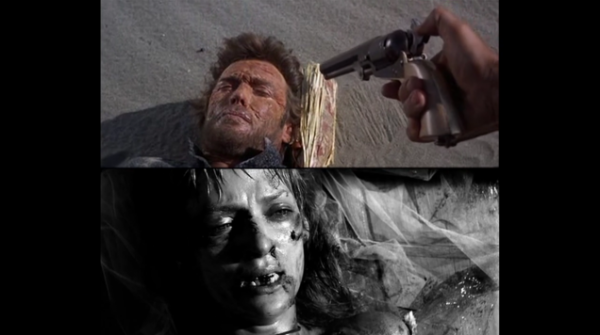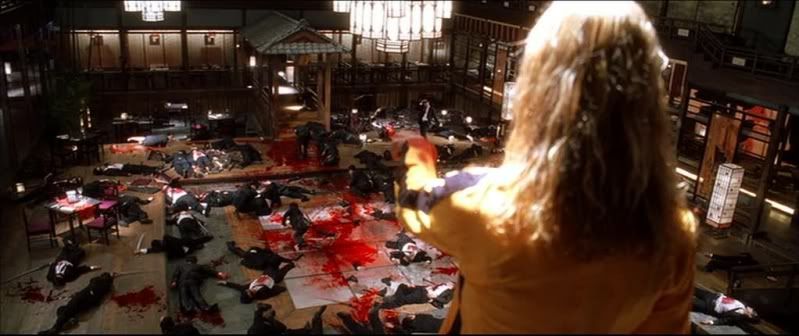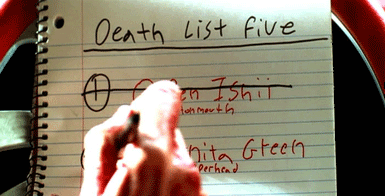 |
| Fig. 1 Kill Bill: Vol. 1 Poster |

Kill Bill: Vol. 1 is a wonderful example of how the postmodern approach of taking influences from pre-existing material and combining it for your own needs can create something unique. A plethora of martial arts and western genre film references welcomes the audience into the world of the director, Quentin Tarantino.
 |
| Fig. 2 Screenshot of direct visual reference. |
Tarantino is a real lover of film and its visual storytelling. Kill Bill's extensive borrowing of techniques from other existing films either visually or musically, is proof of this. As Dominique Mainon and James Ursini explain: "one cannot help but feel that the film was ultimately made primarily for Tarantino's own viewing pleasure, with the audience of secondary concern." (Mainon, Ursini, 2006:206) There are so many films referenced that are both mainstream and niche that it can feel to the viewer that his films are solely designed for him to enjoy at the expense of good narrative and depth, but Mainon and Ursini go on to say that despite this "it is easy to be drawn into it. Tarantino's universe is a frenetically paced world with all the trappings of a fourteen-year-old boy's adventure fantasy, a psychological counselling session, and a manic pop culture/media experiment" (Mainon, Ursini, 2006:206). Kill Bill: Vol. 1 certainly has the frenetic energy they mention. It is seen through the quite spectacular jumping between different intertextual references, such as The Bride's biker outfit 'taken' from Bruce Lee's The Game of Death to a fight sequence mirroring one from Samurai Fiction.
 |
| Fig. 3 The Bride destroys O-Ren's henchmen. |
The fight sequences displayed in Kill Bill are incredibly frenetic but also vicious, bloody and gory. One of the most interesting aspects of these gory fight scenes is that all this vengeful killing is done by a female lead, and the victims she confronts from her list, for this film at least, are all also female. Diane Negra and Yvonne Tasker believe that the "Intense bloodshed in Kill Bill is reserved for female opponents, and each of the personally motivated battles occurs within enclosed, domestic, or at the very least quiet and incongruous spaces for violence... Varied in tone, theme, narrational style, and context, all of these fight scenes are defined by the strong kinetic action of the heroine." (Negra, Tasker, 2007:160) The violence within this film is often considered gratuitous, the use of a female lead is usually to act as added titillation to the violence, but in Kill Bill Tarantino is deliberately drawing the audience's attention to this. One of the most interesting themes in these films is that the heroine is acting as the hero seeking revenge and it isn't until she's immobilised that she becomes overtly sexualised by the men around her. Negra and Tasker go on to express that "Kill Bill foregrounds violence and gender, doing so in a way that emphasizes its own commodification, stylistic extravagance, superficiality, and cultural appropriation... the film offers a spectacle of gender and aestheticized violence that simultaneously deflects and invites or provokes our critical attention to its discourses of gender" (Negra, Tasker, 2007:154) Tarantino has deliberately taken the stereotypes and clichés that are associated with violence and the women that either endure or dispense it, and used them to challenge the audience's belief. He wants them to see that these old, exploitative themes, when seen from someone else's view, can actually be challenging and quite stylised spectacle.
 |
| Fig.4 The Bride's Death List. |
It isn't just the use of violence and stereotypes that Tarantino wants to employ to create an interesting narrative either. M. Keith Brooker explains that the Kill Bill films "are not about violence, but about movies; they are really about their own making - and the making of films in general." (Brooker, 2007:93) Tarantino is also well known for using many different techniques when making his films, and one of these is the non-linear narrative. The film begins by telling the audience that one of The Bride's targets is already dead, and we go on to watch her kill the second. Of course we go back to see her first victim, by doing so Tarantino can make a fairly ordinary story of revenge feel fresh and much more interesting to the audience. Not only do we have the non-linear narrative, showing us only certain elements of the story, but there are titles used in order to divide it further. Philip John Gillett construed that "The flashback structure makes events difficult to follow, yet by dividing the narrative with inter-titles which place events in a time sequence, Tarantino is indicating that the story cannot be dismissed in favour of the excitement of the moment." (Gillett, 2008:Section 16) Tarantino wants the audience to be completely under his control, they can only see what he wants them to see, when he wants them to see it. This technique means that the audience can't predict what will happen next, allowing for the director to keep them enthralled by a fight sequence one moment and then by a character's origin story the next.
Kill Bill: Vol. 1 is, on paper, a simple story of revenge, but in reality it is a postmodern journey into the realms of extreme intertextuality. The audience gets stylised violence, beautiful visual language and a fantastic soundtrack. Brooker describes it as "if Pulp Fiction remains the best film by Tarantino, the Kill Bill films are clearly the films that best represent Tarantino's special traits as a filmmaker." (Brooker, 2007:94) This is exactly that. Kill Bill shows how elegantly Tarantino can visually portray influences and references from the genres he loves so dearly.
List of Illustrations
Figure 1. Kill Bill: Vol.1 poster (2003) At: http://www.movieposterdb.com/posters/05_02/2003/0266697/l_8175_0266697_4af8c109.jpg (Accessed on: 24.09.11)
Figure 2. Screenshot of direct visual reference (2003) At: http://designyoutrust.com/wp-content/uploads/2011/05/Everything-Is-A-Remix-KILL-BILL-1-600x335.png (Accessed on: 24.09.11)
Figure 3. The Bride destroys O-Ren's henchmen (2003) At: http://filmjournal.net/mjocallaghan/files/2007/07/killbill1.jpg (Accessed on: 24.09.11)
Figure 4. The Bride's Death List (2003) At: http://media.tumblr.com/tumblr_lqd0dqL3Z91qkl8dr.gif (Accessed on: 24.09.11)
Bibliography
Booker, M. Keith (2007) Postmodern Hollywood: what's new in film and why it makes us feel so strange. USA: Praeger Publishers.
Gillett, Philip John (2008) Movie greats: a critical study of classic cinema. New York: Berg Editorial offices.
Mainon, Dominique, Ursini, James (2006) Modern Amazons: warrior women on screen. New Jersey: Limelight Editions.
Negra, Diane, Tasker, Yvonne (2007) Interrogating postfeminism: gender and the politics of popular culture. USA: Duke University Press.
Tarantino's References:

Nice review as always.
ReplyDeleteI find QT's films (and the man himself) incessantly annoying these days. I enjoy his first four films (Reservoir Dogs, Pulp Fiction, Jackie Brown and Kill Bill). They were novel films, but the man seriously needs a new shtick. Everything he's done since Kill Bill 1 has been a hackneyed retread if you ask me.
I enjoyed Inglorious Bastards though - very, very suspenseful in places, for instance the opening scene, and the moment the spy gives himself away in the nightclub - and Molly - this is an authentic, proper review that seeks to link the example to the main subject - which is the key requirement of the main essay. Good stuff! :D
ReplyDeleteTarantino is a very strange, quite irritating man but I do enjoy his films. I also really enjoyed how extreme the characters in Inglorious Basterds were, especially Christoph Waltz's character, he was terrifying!
ReplyDeleteThank you Phil! I did try to link them, so hopefully I'll be alright by the time I get to my essay :P